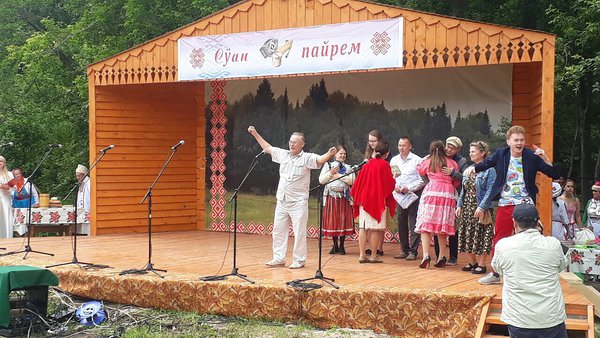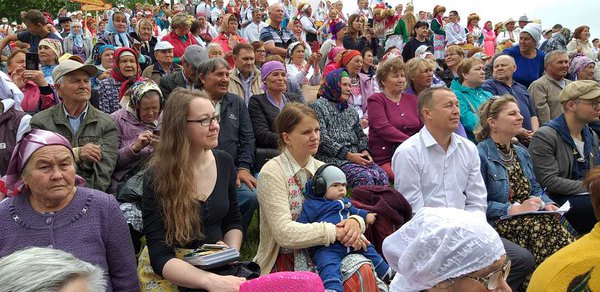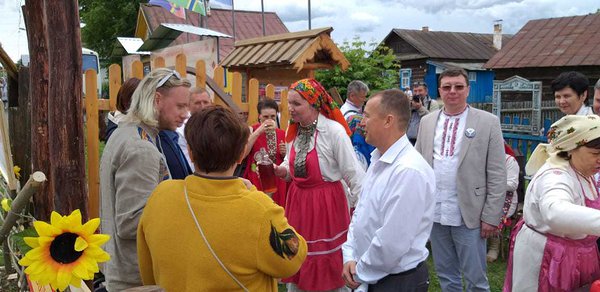On June 14, winner of the Finno-Ugric Capital of Culture 2020 competition was announced in Shorunzha (Mari El Republic), the current title-holder. The next Finno-Ugric Capital of Culture is Mishkino village in the Republic of Bashkortostan (Russian Federation).
Mishkino, a village of 7000 residents of whom 60% are ethnic Mari, is located in the predominantly Bashkir and Tatar speaking Bashkortorstan. Hence, Mishkino will be the first Finno-Ugric Capital of Culture located in a region where majority population speaks Turkic languages.
Mishkino was selected by an independent international jury as the
Finno-Ugric Capital of Culture 2020 from
among three candidates, including Estonia’s Viru-Nigula Rural Municipality and Kihnu island.
Photo: Jury congratulates Mishkino delegation on winning the title of Finno-Ugric Capital of Culture 2020.
In the words of Käbi Suvi, President of the Youth Association of Finno-Ugric Peoples (MAFUN) and Chair of the jury, „Mishkino ultimately won thanks to its thorough application, youthful energy and the novelty of its location – i.e., outside the Finno-Ugric world as it is traditionally perceived. Nonetheless, Mishkino is every bit part of the wider Finno-Ugric world as majority of village residents are indigenous Maris.“
Further reasons to award the title to Mishkino included the upcoming 300-year village anniversary in 2020, as well as integration of its programme with the CIOFF International Folkloriada that will be held in Bashkortostan in 2020.
According to Eda-Riin Leego, jury member from Estonia (representing Fenno-Ugria Youth), this decision did not come easily, „In the end, the jury was debating between Mishkino and Viru-Nigula who had also a strong application with many innovative programme elements such as a sauna festival and emphasis on revitalizing the regional dialect (coastal language). We hope that Viru-Nigula will continue collaborating with the Finno-Ugric Capital of Culture programme in the future.“
Photo: Villagers of Shorunzha and members of international jury are observing the ceremony of announcing Finno-Ugric Capital of Culture 2020.
Nadezhda Gainetdinova, member of the Mishkino
delegation, views the cultural capital year as a significant opportunity for
Mishkino and Bashkortostan., „Most importantly, we would like to make a cultural
contribution to Finno-Ugric peoples in Bashkortostan and in our neighbouring regions.“
The flagship event of the Finno-Ugric Capital of Culture 2020 year will be a bear
festival in the autumn – given that the village name both in Mari and Russian
refers to the bear, and due to the significance of bear in the mythology and
identity of many Finno-Ugric peoples.
Finno-Ugric Capitals of Culture is an initiative by the Youth Association
of Finno-Ugric Peoples (MAFUN) established in 2013. Its aims are to raise awareness
of Finno-Ugric peoples and languages, to strengthen International Finno-Ugric
collaboration and to stimulate local socio-economic development in Finno-Ugric
regions. Past holders of the Finno-Ugric Capital of Culture are Bygy (2014, Udmurtia),
Obinitsa (2015, Estonia), Iszkaszentgyörgy and Veszprem (2016, Hungary),
Vuokkiniemi (2017, Karelia), current title-holder is Shorunzha (Mari El). URALIC
Centre for Indigenous Peoples NGO (Estonia) currently serves as the secretariat
of the Finno-Ugric Capitals of Culture programme.
Further information:
Oliver Loode (Oliver.loode@uralic.org, Tel. +372 513 2992)



14 replies